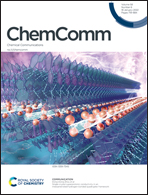Three-component 1,2-dicarbofunctionalization of alkenes involving alkyl radicals
Abstract
1,2-Dicarbofunctionalization of alkenes represents an appealing strategy for chemical bond formation in organic synthesis, which could enable the rapid construction of molecular complexity from simple and readily available starting materials by incorporating two functional groups onto a carbon–carbon double bond in one step. In this field, the dicarbofunctionalization of alkenes with different alkyl radicals in a controlled manner represents an elegant and versatile strategy to access structurally diverse functionalized alkanes, which have witnessed significant progress over the last five years. Due to the importance of alkyl radicals in organic synthesis and medicinal chemistry, this review provides a comprehensive perspective on the development of alkyl radical precursors including electrophilic precursors such as alkyl halides, alkyl peroxides, alkyl NHP esters, cycloketone oxime esters, and Katritzky pyridinium salts, and nucleophilic precursors such as alkyl acids, alkyl oxalates, alkylborates, alkylsilicates, and unactivated hydrocarbons, which generate alkyl radicals by photocatalysis or transition metal catalysis to engage in dicarbofunctionalization under oxidative reaction conditions, redox-neutral conditions, or reductive conditions. The mechanisms of these dicarbofunctionalization reactions have also been discussed in detail.



 Please wait while we load your content...
Please wait while we load your content...